双写形容词以及副词辅音字母的比较级和最高级
- 格式:doc
- 大小:33.00 KB
- 文档页数:1
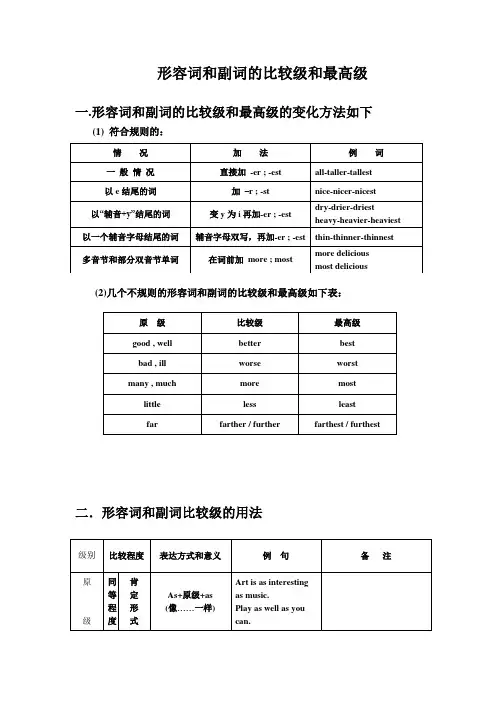
形容词和副词的比较级和最高级一.形容词和副词的比较级和最高级的变化方法如下(1) 符合规则的:(2)几个不规则的形容词和副词的比较级和最高级如下表:二.形容词和副词比较级的用法注意:有些形容词,如 dead, empty, round, sure, woolen 等受本身含义的限制,没有比较级。
例题解析1. He is ________ friends than I.A. much moreB. many moreC. very moreD. too more解析:后面有可数名词复数时,many的比较级形式为many more 修饰。
应选B.2. Which is the _________ country, Japan or Australia?A. more developedB. more developingC. most developedD. most developing解析:两者比较用比较级,表示"发达"用developed, 而developing 是"发展中的" 意思3. There were _______ shops in the city in 1982 than in 1990.A. littleB. fewC. fewerD. less解析:little 不能修饰可数名词,两者比较需用比较级,所以应选C.4. If you are not free today, come another day __________.A. tooB. soC. insteadD. yet解析:instead 作副词用时意为"代替,顶替",表示前面的事情没做,而是做了后面的事。
Instead一般位于句首。
应选C.5.He can't tell us ________, I think.A. important anythingB. anything importantC. important somethingD. something important.解析:不定代词与形容词联用需后置,否定句中应该用anything而不是something. 因此应选B6. The Huang River is the second __________ river in our country.A. longB. longerC. longestD. the longest解析:"定冠词the+ 序数词+ 形容词最高级" 表示"第几大……" 应选C.7. The light in the office wasn't ________for him to read.A. enough brightB. bright enoughC. brightlyD. enough brightly解析:enough修饰名词时可前可后,修饰形容词或副词时,要后置。
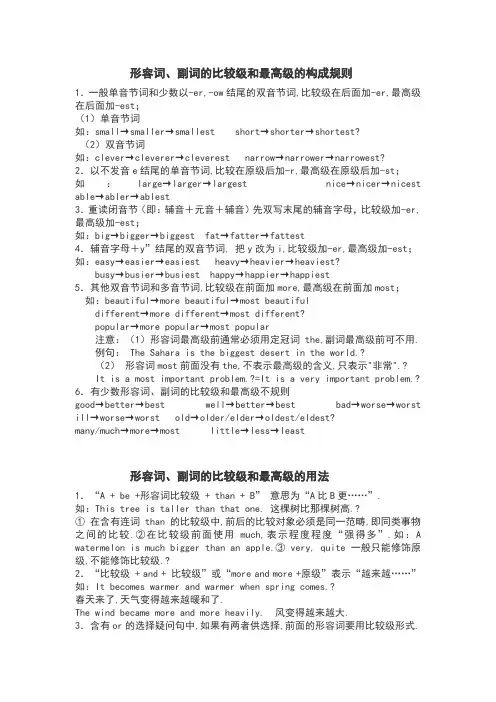
形容词、副词的比较级和最高级的构成规则1.一般单音节词和少数以-er,-ow结尾的双音节词,比较级在后面加-er,最高级在后面加-est;(1)单音节词如:small→smaller→smallest short→shorter→shortest?(2)双音节词如:clever→cleverer→cleverest narrow→narrower→narrowest?2.以不发音e结尾的单音节词,比较在原级后加-r,最高级在原级后加-st;如:large→larger→largest nice→nicer→nicest able→abler→ablest3.重读闭音节(即:辅音+元音+辅音)先双写末尾的辅音字母,比较级加-er,最高级加-est;如:big→bigger→biggest fat→fatter→fattest4.辅音字母+y”结尾的双音节词, 把y改为i,比较级加-er,最高级加-est;如:easy→easier→easiest heavy→heavier→heaviest?busy→busier→busiest happy→happier→happiest5.其他双音节词和多音节词,比较级在前面加more,最高级在前面加most;如:beautiful→more beautiful→most beautifuldifferent→more different→most different?popular→more popular→most popular注意:(1)形容词最高级前通常必须用定冠词 the,副词最高级前可不用.例句: The Sahara is the biggest desert in the world.?(2)形容词most前面没有the,不表示最高级的含义,只表示"非常".?It is a most important problem.?=It is a very important problem.? 6.有少数形容词、副词的比较级和最高级不规则good→better→best well→better→best bad→worse→worst ill→worse→worst old→older/elder→oldest/eldest?ma ny/much→more→most little→less→least形容词、副词的比较级和最高级的用法1.“A + be +形容词比较级+ than + B” 意思为“A比B更……”.如:This tree is taller than that one. 这棵树比那棵树高.?① 在含有连词than的比较级中,前后的比较对象必须是同一范畴,即同类事物之间的比较.②在比较级前面使用much,表示程度程度“强得多”.如:A watermelon is much bigger than an apple.③ very, quite一般只能修饰原级,不能修饰比较级.?2.“比较级 + and + 比较级”或“more and more +原级”表示“越来越……”如:It becomes warmer and warmer when spring comes.?春天来了,天气变得越来越暖和了.The wind became more and more heavily. 风变得越来越大.3.含有or的选择疑问句中,如果有两者供选择,前面的形容词要用比较级形式.如:Who is taller,Tim or Tom? 谁更高,Tim还是Tom?4. “the +比较级……, the+比较级”,表示“越……越……”.The sooner,the better.?越快越好.5. 表示倍数的比较级用法:①. A is …times the size /height/length/width of B.?如:The new building is three times the height of the old one.这座新楼比那座旧楼高三倍.(新楼是旧楼的四倍高)②. A is …times as big /high/long/wide/large as B.如:Asia is four times as large as Europe.亚洲是欧洲的四倍大.(亚洲比欧洲大三倍)③. A is …times larger /higher/longer/wider than B.如:Our school is twice bigger than yours.我们学校比你们学校大两倍.6.形容词、副词的最高级形式主要用来表示三者或三者以上人或事物的比较,表示“最……”的意思.如:He is the tallest in our class.?他在我们班里是最高的.7."否定词语+比较级","否定词语+ so… as"结构表示最高级含义.?Nothing is so easy as this.?=Nothing is easier than this.?=This is the easiest thing.8. 比较级与最高级的转换:?Mike is the most intelligent in his class.?Mike is more intelligent than any other student in his class9.修饰比较级和最高级的词(1)可修饰比较级的词①.a bit, a little, rather, much, far, by far, many, a lot, lots, a great deal, any, still, even等.??(除by far外,必须置于比较级形容词或副词的前面.?)②. 可用表倍数的词或度量名词作修饰语. (2)下列词可修饰最高级:by far, far, much, mostly, almost.?This hat is nearly / almost the biggest.?10. 序数词通常只修饰最高级.?11.要避免重复使用比较级.?12.要避免将主语含在比较对象中.?13.要注意冠词的使用,后有名词的时候,前面才有可能有名词.?。

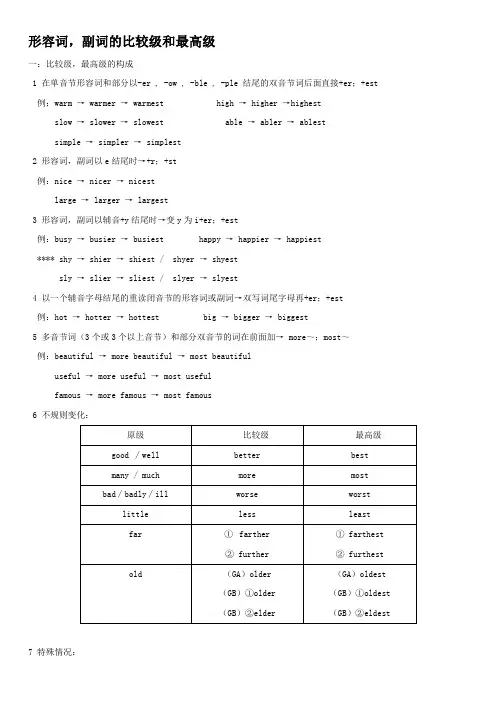
形容词,副词的比较级和最高级一:比较级,最高级的构成1 在单音节形容词和部分以-er , -ow , -ble , -ple 结尾的双音节词后面直接+er;+est 例:warm → warmer → warmest high → higher →highest slow → slower → slowest able → abler → ablestsimple → simpler → simplest2 形容词,副词以e结尾时→+r;+st例:nice → nicer → nicestlarge → larger → largest3 形容词,副词以辅音+y结尾时→变y为i+er;+est例:busy → busier → busiest happy → happier → happiest**** shy → shier → shiest / shyer → shyestsly → slier → sliest / slyer → sl yest4 以一个辅音字母结尾的重读闭音节的形容词或副词→双写词尾字母再+er;+est例:hot → hotter → hottest big → bigger → biggest5 多音节词(3个或3个以上音节)和部分双音节的词在前面加→ more~;most~例:beautiful → more beautiful → most beautifuluseful → more useful → most usefulfamous →more famous → most famous6 不规则变化:7 特殊情况:⑴下列各词无比较级和最高级:wrong right correct true empty perfect excellent unique extreme extremely ready possible possibly chief main mainly final sufficient fatal primary absolute absolutely entire entirely infinite naked favorite⑵下列单音节词变比较级和最高级时在前面加more~;most~累的:tired → more tired → most tired高兴的:glad → more glad → most glad无聊的:bored → more bored → most bored喜欢的:fond → more fond → most fond高兴的,愉快的:pleased → more pleased → most pleased用旧的,用坏的:worn → more worn → most worn真的,真实的:real → more real → most real热衷的,喜爱的,着迷的:keen → more keen → most keen⑶下列词即可以直接+er;+est,又可以more~;most~聪明的 clever → cleverer → cleverest / more clever → most clever经常 often → oftener → oftenest / more often → most often残酷的 cruel → crueler → cruelest / more cruel → most cruel严厉的 strict → stricter → strictest / more strict → most strict狭窄的,狭隘的narrow → narrower → narrowest / more narrow → most narrow淘气的naughty → naughtier → naughtiest / more naughty → most naughty困的,想睡觉的sleepy → sleepier → sleepiest / more sleepy → most sleepy友好的friendly → friendlier → friendliest/ more friendly → most friendly充满活力的,活泼的lively → livelier → liveliest/ more lively → most lively安全的,可靠的secure → securer → securest / more secure → most secure浅的,肤浅的,无关紧要的shallow → shallower → shallowest / more shallow → most shallow有名的,众所周知的 well-known → better-known → best-known / more well-known → most well-known二:公式;1.A+V.+as+a.∕ad.(原级)+as+B.(as…as… 像…一样)→同级比较例句:This tree is as big as that one. 这棵树和那棵一样大。
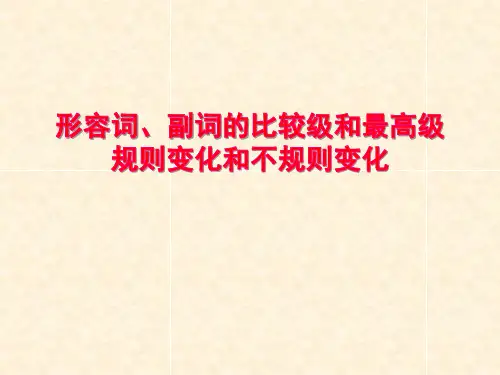
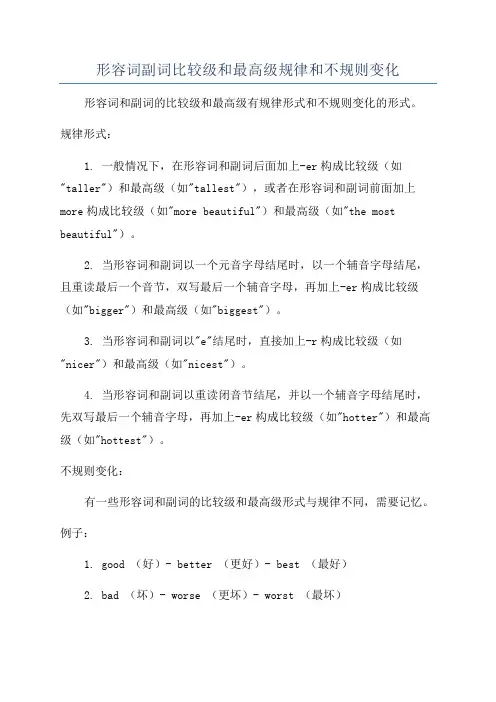
形容词副词比较级和最高级规律和不规则变化形容词和副词的比较级和最高级有规律形式和不规则变化的形式。
规律形式:1. 一般情况下,在形容词和副词后面加上-er构成比较级(如"taller")和最高级(如"tallest"),或者在形容词和副词前面加上more构成比较级(如"more beautiful")和最高级(如"the most beautiful")。
2. 当形容词和副词以一个元音字母结尾时,以一个辅音字母结尾,且重读最后一个音节,双写最后一个辅音字母,再加上-er构成比较级(如"bigger")和最高级(如"biggest")。
3. 当形容词和副词以"e"结尾时,直接加上-r构成比较级(如"nicer")和最高级(如"nicest")。
4. 当形容词和副词以重读闭音节结尾,并以一个辅音字母结尾时,先双写最后一个辅音字母,再加上-er构成比较级(如"hotter")和最高级(如"hottest")。
不规则变化:有一些形容词和副词的比较级和最高级形式与规律不同,需要记忆。
例子:1. good (好)- better (更好)- best (最好)2. bad (坏)- worse (更坏)- worst (最坏)3. far (远)- further/farther (更远)- furthest/farthest (最远)4. many/much (多)- more (更多)- most (最多)5. little (少)- less (更少)- least (最少)6. well (好)- better (更好)- best (最好)7. badly (坏)- worse (更坏)- worst (最坏)需要注意的是,有些形容词和副词只有原级,没有比较级和最高级,如perfect(完美的)、unique(独一无二的)、correct(正确的)等。

形容词和副词的比较级和最高级(完美版)一、形容词和副词的比较级和最高级的变化方法如下:1) 符合规则的情况:一般情况:直接加-er;-est以e结尾的词:加-r;-st以“辅音+y”结尾的词:变y为i再加-er;-est以一个辅音字母结尾的词:辅音字母双写,再加-er;-est例词:all-taller-tallest,nice-nicer-nicest,dry-drier-driest,heavy-heavier-heaviest,XXX-XXX-XXX2) 几个不规则的形容词和副词的比较级和最高级如下表:原级:good。
well;bad。
ill;many。
much;little;far二、形容词和副词比较级的用法:级别比较程度肯定表达方式和意义例句(备注)原级同等程度 As+原级+as (像……一样) XXX。
not + so (as) +原级+as (不如……那样) English is not so difficult as science。
比较级不同程度 (用于两者比较) 比较级+than (比……) XXX XXX。
比较级前面可以加much。
far。
even。
still。
a lot。
a little。
a bit等程度加深 I like pork better than beef。
最高级同一范围内的最高程度 The +比较级,the +比较级(越……,越……) XXX gets。
the XXX.The XXX reads。
the better their XXX。
This is because reading can XXX.The highest degree of something is expressed using the superlative form。
which is used for three or more things。
Forexample。
"Spring is the best season of the year." Another example is "Lin Tao jumped the farthest of all."When using the superlative form with an adverb。
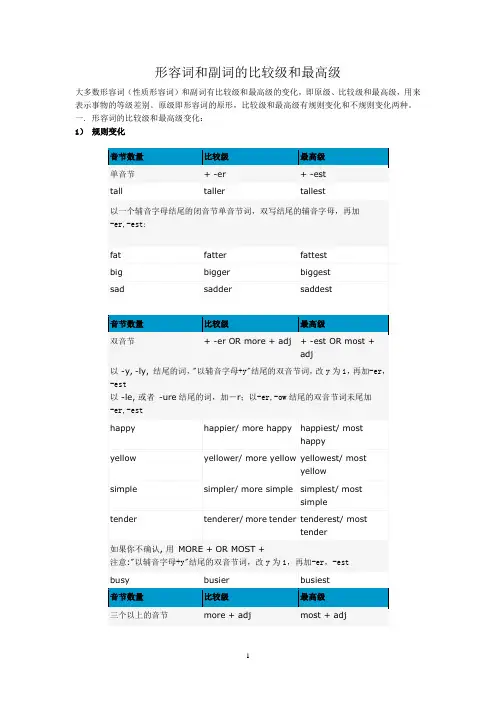
形容词和副词的比较级和最高级大多数形容词(性质形容词)和副词有比较级和最高级的变化,即原级、比较级和最高级,用来表示事物的等级差别。
原级即形容词的原形,比较级和最高级有规则变化和不规则变化两种。
一. 形容词的比较级和最高级变化:1)规则变化例如:a. A cat is fast, a tiger is faster but a cheetah is the fastestb. A car is heavy, a truck is heavier, but a train is the heaviestc. A park bench is comfortable, a restaurant chair is more comfortable, but a sofa is the most comfortable2)不规则变化二. 副词的比较级和最高级变化:通常说来,副词的比较级和最高级与形容词的比较级最高级形式相同:•短副词后加-er or -est:例如: Jim works harder than his brother.Everyone in the race ran fast, but John ran the fastest of all.以-ly结尾的副词, 用more +副词做比较级,most+副词做最高级:例如: The teacher spoke more slowly to help us to understand.Could you sing more quietly please?有的副词有不规则的比较级形式You're driving worse today than yesterday !注意!有时候'most' 意味着'very':•We were most grateful for your helpI am most impressed by this application.。

形容词副词比较级最高级变化规则及用法形容词的比较级和最高级的变化规则如下:1. 一般情况下,在形容词的原级后加-er作为比较级,加-est作为最高级。
例如:原级:tall(高)比较级:taller(更高)最高级:tallest(最高)2. 以字母“e”结尾的形容词,在原级后只加-r作为比较级,加-st作为最高级。
例如:原级:large(大的)比较级:larger(更大的)最高级:largest(最大的)3. 以元音字母加辅音字母结尾的单音节形容词,在原级后双写最后一个辅音字母,再加-er作为比较级,加-est作为最高级。
例如:原级:hot(热的)比较级:hotter(更热的)最高级:hottest(最热的)4. 以辅音字母加-y结尾的形容词,在原级中把-y改为-i,再加-er作为比较级,加-est作为最高级。
例如:原级:funny(有趣的)比较级:funnier(更有趣的)最高级:funniest(最有趣的)副词的比较级和最高级的变化规则如下:1. 大多数副词在前面加more形成比较级,在前面加most形成最高级。
例如:原级:quickly(快速地)比较级:more quickly(更快速地)最高级:most quickly(最快速地)2. 以字母“e”结尾的副词,在前面只加-r形成比较级,加-st形成最高级。
例如:原级:late(迟)比较级:later(更迟)最高级:latest(最迟)3. 以字母“y”结尾的副词,在前面把-y改为-i,再加-er形成比较级,加-est形成最高级。
例如:原级:busy(忙碌地)比较级:busier(更忙碌地)最高级:busiest(最忙碌地)需要注意的是,有些形容词和副词的比较级和最高级形式并不遵循以上的规则,而是需要记忆。
例如:good(好的)- better(更好的)- best(最好的), well(好地)- better(更好地)- best(最好地)。


形容词/副词比较级最高级变化形式及用法1 、一般情况下,单音节或双音节的形容词(或副词)比较级+er ,最高级+est clever-cleverer-cleverest few-fewer-fewest small-smaller-smallest young-younger-youngest tall-taller-tallest long-longer longestshort-shorter-shortest strong-stronger-strongest warm-warmer-warmest slow-slower-slowest old-older-oldest high-higher-highest light-lighter-lightest fast-faster-fastest great—greater—greatest cool-cooler-coolest clean-cleaner-cleanest cheap-cheaper-cheapest quick-quicker-quickest2、以不发音e结尾的单音节词,比较在原级后加-r,最高级在原级后加-st;nice-nicer-nicest late-later-latest able-abler-ablestbrave-braver-bravestcute-cuter-cutest large-larger-largest close-closer-closest(亲密的)fine-finer-finest white-whiter-whitest free- freer-freest(免费的)3、以“辅音字母+y”结尾的双音节词,把y改为i,比较级加-er,最高级加-est;easy-easier-easiest happy-happier-happiest early-earlier-earliest busy-busier-busiest heavy-heavier-heaviest dirty-dirtier-dirtiestlazy-lazier-laziest dry-drier-driest pretty-prettier-prettiest funny-funnier-funniest healthy-healthier-healthiest4、在重读闭音节(即:辅音+元音+辅音)中,先双写末尾的辅音字母,比较级加-er,最高级加-est;fat-fatter-fattest thin-thinner-thinnest hot-hotter-hottestfit-fitter-fittest(合适的) red-redder-reddest wet-wetter-wettestbig-bigger-biggest sad-sadder-saddest5、其他双音节词和多音节词,比较级在前面加more,最高级在前面加most;beautiful -more beautiful - most beautifulcareful-more careful-most carefulintelligent-more intelligent-most intelligentexpensive delicious(美味的) popular(流行的) important(重要的)interesting(有趣的) afraid(害怕)quickly(迅速地的) quietly (安静地)6、少数单音节词也是这样;pleased-more pleased -most pleasedtired-more tried -most tired7、少数不规则形容词、副词的比较级和最高级,必须熟记。
(一 )比较级和最高级的构成:1 加-er,-est 构成比较级和最高级。
【1】单音节形容词和副词high-higher-highest hard-harder-hardest 【2】以不发音的 -e 结尾的safe-safer-safest late-later-latest【3】辅音字母要双写的情况:【4】以辅音加 -y 结尾的情况dry-drier-driest merry-merrier-merrist 2 加 more,most 构成比较级和最高级。
【1】多音节的形容词和副词expensive-more expensive-most expensivecarefully-more carefully-most carefully【2】由形容词加 -ly 构成的副词slowly-more slowly-most slowlyhighly-more highly-most highly【3】以-ful,-less,-able,-ous,-ive,-ing 等结尾的双音节形容词useless-more useless-most uselessserious-more serious-most seriuos【4】分词形容词 tired,pleased 及 glad,often,real,right,wrong 等单音节形容词tired-more tired-most tiredglad-more glad-most glad( 3 )形容词、副词的比较级和最高级的不规则构成法。
bad/ill/badly-worse-worstmany/much-more-mostlittle-less-leastfar-farther/further-farthest/furthestold-older/elder-oldest/eldest(二) 比较级和最高级的用法1 比较级的表示法:主语 +be +比较级+than …;主语+谓语+比较级+than …( 1 )不同主语的比较:He is two years younger than I.This machine works better than that one.Li Ming studies harder than Wang Ling.( 2 )同一主语不同方面的比较:She is now happier than she has ever been.The exam was easier than we expected.We have had much more rain this year than last year.( 3 )用于修饰比较级的词: even,(very) much,far,a lot,stillThis book is much thicker than that one.He works even harder than before.( 1 ) 形容词和副词最高级的用法三者或三者以上的比较用最高级。
形容词、副词的比较级和最高级(一)形容词、副词比较级和最高级的构成:1. 单音节词和少数双音节词比较级和最高级的规则变化:规则原级比较级最高级1.在词尾后直接加tall taller tallest -er/est2.词尾是e,只加nice nicer nicest -r/st3.以辅音字母加y结尾的,把y变ihappy happier happiest 再加-er/est4.重读闭音节,末尾只有一个辅音thin thinner thinnest 字母,双写这个辅音字母,再加-er/est2. 其他双音节词或多音节词,在该词前面加-more/mostbeautiful—more beautiful—(the) most beautiful3. 由形容词加ly构成的双音节词和多音节词,都是在该词前加-more/most.quickly—more quickly—(the) most quicklydifficultly—more difficultly—(the) most difficultly4. 不规则变化:good/well better bestbad/badly worse worstmany/much more most little less leastfar farther/further farthest/furthest (二)形容词比较级和最高级的用法:1. 原级的用法:用于两者之间对比,意思为“……和……相同”A+v.+as….+形容词原级+as BTom is as honest as Jack.Her skin is as white as snow.My dog is as old as that one.He is not as (=so) tall as I.The weather here is not as(=so)cool as the weather in Harbin.2. 比较级的用法:1)A+形容词比较级+than+ BSusan is happier than Jane.His brother is younger than me.Beijing is more beautiful than Osaka.形容词比较级前还可以用much, even, still, a little,far, a lot, a bit, much more来修饰。
形容词和副词的比较级和最高级大多数形容词有三种形式:原级,比较级和最高级(一)变法1规则变化(1)在形容词或副词后以及以er,ow,ure,le结尾的双音节形容词或副词后,加er/est或r/st.如:tall-taller-tallest clever-cleverer-cleverest(2)在以e结尾的形容词或副词后加-r,-st.如:brave-braver-bravest(3)以辅音字母+y结尾的形容词或副词,改y为i再加er/est.如:early-earlier-earliest(4)以一个字母结尾的重读闭音节形容词或副词,双写辅音字母加ing。
如:big-bigger-biggest(5)在多音节的形容词或副词前加more/most,表示比较级和最高级如:careful-more careful-most careful(6)在某些单音节形容词,如tired,pleased,right,real,glad等,加more/most 如:tired-more tired-most tired(7)复合形容词或副词一般用more/most形式,但如果合成词中第一词是单音节词,也可以加er/est。
如:narrow-minded---more narrow-minded---most narrow-minded kind-hearted---kinder-hearted---kindest-hearted2不规则变化原级比较级最高级well/good better bestbad/badly/ill worse worstmany/much more mostlittle less leastfar farther/further farthest/furthestold older/elder oldest/eldest(二)形容词和副词比较级的用法1.表示A超过B时,用基本句式:(1)A+谓语(系动词)+形容词比较级+than+BThis pen is better than that one.The book is more interesting than that one.(2)A+谓语(行为动词)+副词比较级+than+BHe runs faster than JimHe speaks English better than I2.表示A不及B,用基本方式(1)A+谓语的否定式+形容词或副词的比较级+than+BThis room isn’t bigger than mine.He doesn’t run faster than his brother.(2)A+谓语+less+形容词或副词的原形+ than+BI am less tall than he.He does his homework less carefully than his brother.(3)A+谓语的否定式+so(as)+形容词或副词的原级+as+B如:Mrs Brown is not so old as she looks.布朗夫人不像她的外表那么老。